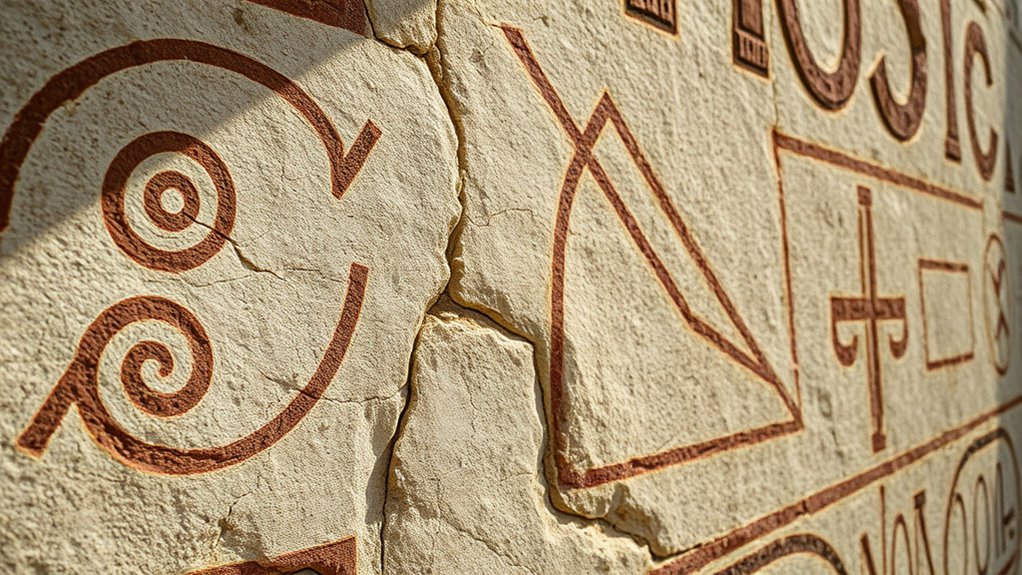Semiotics and symbolism show how you communicate complex ideas through signs, images, and gestures rooted in shared cultural meanings. Symbols are powerful tools that evoke recognition and understanding without words, relying on cultural codes and social agreements. These signs carry layered messages, often influenced by context and history. Recognizing how signs function helps you interpret everyday symbols and understand their deeper significance. If you keep exploring, you’ll uncover more about the fascinating ways humans create meaning through signs.
Key Takeaways
- Semiotics studies how signs and symbols create and transmit meaning within cultural contexts.
- Symbols function as carriers of layered, socially constructed meanings beyond their physical form.
- Recognition of signs depends on shared cultural codes and collective understanding.
- Visual symbols evoke recognition and emotional responses, shaping perceptions and communication.
- The meaning of signs evolves over time, reflecting social and cultural shifts.

Have you ever wondered how symbols communicate complex ideas without words? It’s fascinating to realize that much of our understanding relies on a visual language that transcends spoken language. Every sign, symbol, or gesture carries meaning, often rooted in shared cultural codes that make communication instant and intuitive. When you see a red cross, you recognize it as a symbol of medical aid, thanks to the cultural codes developed over time. These codes are the unspoken rules that tell you what symbols stand for within a specific society. They’re the foundation of semiotics—how meaning is created and interpreted through signs.
Visual language is powerful because it bypasses the need for words, instead relying on images and symbols that evoke recognition and understanding. For example, traffic lights use simple colors and shapes that almost everyone understands, regardless of language barriers. This universal visual language is built on cultural codes that assign specific meanings to colors and symbols. Yet, these codes aren’t static—they evolve with time and context. A skull might symbolize danger or death in one culture, but in another, it could represent rebellion or celebration. As a result, interpreting signs requires understanding the cultural context in which they are embedded, because the same symbol can have different meanings across societies.
You’re constantly interpreting these visual cues daily, often without realizing it. When you see a dove, you probably associate it with peace, a cultural code ingrained in many societies. When you spot a flag waving, you recognize national identity through a shared cultural symbol. These signs are deeply embedded in your cultural experience, shaping how you perceive and respond to the world around you. Semiotics explores how these signs function and how their meanings are constructed. It reveals that symbols are not just arbitrary images—they are carriers of layered meanings, built through social agreements and cultural histories. Additionally, the study of natural signs shows how some meanings are rooted in biological or environmental cues shared across human societies.
Understanding the relationship between visual language and cultural codes helps you decode the messages around you more effectively. Whether it’s advertising, art, or everyday signage, the signs communicate ideas that go beyond mere visuals. They tap into collective cultural understandings, making messages more powerful and immediate. Recognizing this interplay allows you to see the richness behind seemingly simple symbols. It turns everyday interactions into a deeper exploration of how humans create meaning through signs, demonstrating that communication is much more intricate than words alone can convey.
Frequently Asked Questions
How Do Cultural Differences Influence the Interpretation of Signs?
Cultural differences considerably influence how you interpret signs because cultural nuances shape your understanding and meaning. What seems straightforward in one culture might carry a different or even opposite message in another. You experience interpretive variability, as symbols can have varied connotations based on cultural backgrounds. This means you need to take cultural context into account carefully; otherwise, you risk misinterpreting signs or missing their true significance.
Can Symbols Have Multiple Meanings Across Different Contexts?
Yes, symbols can have multiple meanings across different contexts because they are multivalent symbols. You might see a symbol interpreted differently based on cultural variability, where a sign’s significance shifts depending on cultural norms or situations. When you encounter a symbol, consider the context to understand its intended meaning, as the same sign can convey diverse messages across cultures or settings, reflecting its flexible and layered nature.
What Role Does Context Play in Semiotic Analysis?
Did you know that 70% of meaning interpretation relies on sign context? In semiotic analysis, context is vital because it shapes how you interpret signs. It helps determine the intended meaning and prevents miscommunication. Without considering the surrounding sign context, you might misread symbols or overlook their deeper significance. So, understanding the context allows you to accurately decode signs and grasp their true message.
How Are Digital Signs and Symbols Evolving Today?
Digital signs and symbols are evolving rapidly today. You’ll notice digital iconography becoming more sophisticated, conveying complex ideas with simple visuals. Emojis, for example, are continuously evolving, expanding their meanings and cultural relevance, helping you express emotions more accurately online. This evolution allows you to communicate more efficiently across diverse platforms, bridging language gaps and enriching digital conversations with richer, more nuanced symbols that adapt to changing social contexts.
What Is the Relationship Between Semiotics and Language Development?
Think of language as a garden you cultivate; semiotics is your tool for sign formation and meaning interpretation. As you develop language, you create signs that symbolize ideas, emotions, and concepts. This evolving relationship means you continuously refine how signs represent meaning, shaping communication over time. Your understanding of signs influences language development, making your expressions richer, more nuanced, and better suited to convey complex human experiences.
Conclusion
So, when you decode signs and symbols, you’re opening the universe’s biggest secret vault—an endless treasure chest of meaning! Every sign you see, from a simple wink to a towering monument, is like a secret code revealing humanity’s deepest truths. By mastering semiotics and symbolism, you hold the power to unlock worlds, influence minds, and even change history. Get ready—your journey into the language of signs is the most exciting adventure you’ll ever undertake!









